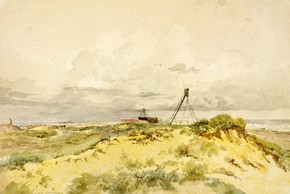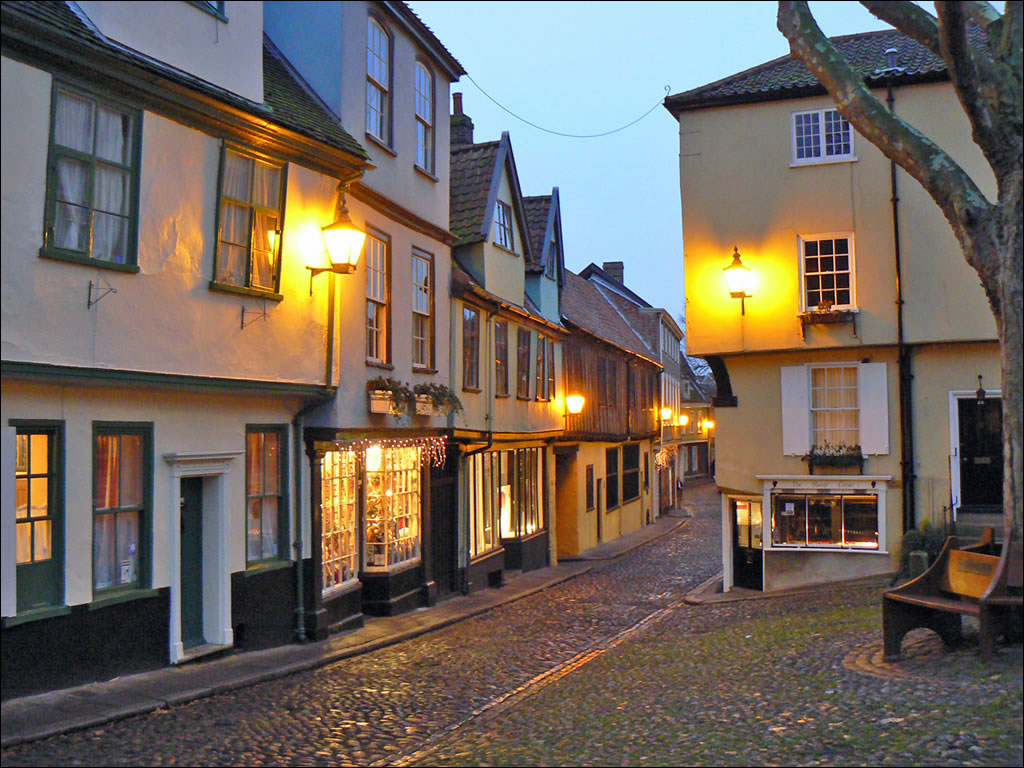
cromerJames Stark (November 19, 1794 – March 24, 1859) was an English landscape painter of the "Norwich School".

 Stark was born in Norwich, the youngest son of Michael Stark (1748–1831), a Scottish-born dyer .and showed a talent for art from an early age.
Stark was born in Norwich, the youngest son of Michael Stark (1748–1831), a Scottish-born dyer .and showed a talent for art from an early age. He was educated at the Grammar School where he became friends with John Berney Crome. He was then apprenticed to John Berney's father, the landscape artist John Crome, for three years from 1811.
He was educated at the Grammar School where he became friends with John Berney Crome. He was then apprenticed to John Berney's father, the landscape artist John Crome, for three years from 1811.
His painting A view on King Street river, Norwich was shown at the Royal Academy in London in 1811, and in the same year he exhibited at the Norwich Society of Artists, of which he was elected a member in 1812. In 1814, following the end of his apprenticeship, he moved to London. He exhibited at the British Institution
 between 1814–8, winning a prize of £50 in 1818. In 1817 he became a student at the Royal Academy Schools.
between 1814–8, winning a prize of £50 in 1818. In 1817 he became a student at the Royal Academy Schools.After only two years of study, ill health forced Stark to return to Norwich
 There he devoted himself to painting the scenery around the city and executed a series of paintings of Norfolk rivers which were eventually engraved and published in 1834. In 1821 he married Elizabeth Younge Dinmore (d. 1834/5).
There he devoted himself to painting the scenery around the city and executed a series of paintings of Norfolk rivers which were eventually engraved and published in 1834. In 1821 he married Elizabeth Younge Dinmore (d. 1834/5).
In 1830, he again settled in London, taking up residence in Chelsea, and exhibited at the British Institution, the Royal Academy and the Society of British Artists. In 1839, he moved to Windsor,
 where he painted many pictures of the scenery along the Thames, but moved back to London in 1849 in order to further his son's artistic education. His only son, Arthur James Stark (1831–1902), born in Chelsea, became a landscapes and animal painter. He drew the cattle on a few of his father's pictures.
where he painted many pictures of the scenery along the Thames, but moved back to London in 1849 in order to further his son's artistic education. His only son, Arthur James Stark (1831–1902), born in Chelsea, became a landscapes and animal painter. He drew the cattle on a few of his father's pictures.Stark died at Mornington Place,
 Camden Town, London, in March 1859.
Camden Town, London, in March 1859.In his pictures the influence of Crome is plainly perceptible, and there is evidence also of his study of the Dutch landscape-painters; but he had little of Crome's largeness and power and his works charm rather by their gentle truth and quietness of manner than by their robustness of view or by their decisiveness of execution.
Stark worked in oils, watercolour, pencil and chalk. Much of his work is kept at the Castle Museum and Art Gallery in Norwich.
The Norwich Society of Artists was founded in 1803 by John Crome and Robert Ladbrooke as a club where artists could meet to exchange ideas. Its aims were "an enquiry into the rise, progress and present state of painting, architecture, and sculpture, with a view to point out the best methods of study to attain the greater perfection in these arts." The society's first meeting was in "The Hole in the Wall" tavern; two years later it moved to premises which allowed it to offer members work and exhibition space. Its first exhibition opened in 1805, and was such a success that it became an annual event until 1825. The building was demolished but the society re-opened three years later, in 1828, as "The Norfolk and Suffolk Institution for the Promotion of the Fine Arts" at a different venue and exhibitions continued until 1833.
The leading light of the movement was undoubtedly John Crome who attracted many friends and pupils until his death in 1821. The mantle of leadership then fell on John Sell Cotman,
 a member of the society since 1807, who continued to keep the society together until he left Norwich for London in 1834 to take up a post at King's College School. The society effectively ceased to exist from that date.
a member of the society since 1807, who continued to keep the society together until he left Norwich for London in 1834 to take up a post at King's College School. The society effectively ceased to exist from that date.
The Norwich School's great achievement was that a small group of self-taught working class artists
 were able to paint with vitality the hinterland surrounding Norwich, assisted by meagre local patronage. Far from creating pastiches of the Dutch 17th century,
were able to paint with vitality the hinterland surrounding Norwich, assisted by meagre local patronage. Far from creating pastiches of the Dutch 17th century, Crome and Cotman, along with Joseph Stannard,
Crome and Cotman, along with Joseph Stannard, established a school of landscape painting which deserves greater fame; the broad washes of Cotman's water-colours anticipate French impressionism.
established a school of landscape painting which deserves greater fame; the broad washes of Cotman's water-colours anticipate French impressionism.The reason the Norwich School artists are not so well known as other painters of the period, notably Constable and Turner, is because the majority of their canvases were collected by the industrialist J. J. Colman (of Colman's mustard fame), and have been on permanent display in Norwich Castle Museum since the 1880s. The lack of exposure was remedied in 2001, when many of the school's major works were exhibited outside Norwich for the first time at the Tate Gallery, London.
In 1986 Norwich Castle museum acquired a late masterwork by John Crome entitled Back of New Mills Evening dated circa 1812-1819. It is interesting to note that its composition includes a small boy trailing a toy boat from the stern of a boat. The identical motif occurs in Joseph Stannard's
 masterwork Thorpe Water Frolic of 1828. The Thorpe Water Frolic was an idea of the wealthy merchant Thomas Harvey from his witnessing water-festivities at Venice while on the Grand tour of Europe. Begun in 1824 the Thorpe Water-Frolic attracted crowds of over 30,000 when the population of Norwich was at that time little more than 10,000. A welcome day of rest for the many weavers of Norwich who often worked in cramped conditions, the Water-frolic was enjoyed as a rare day of recreation in the fresh air.
masterwork Thorpe Water Frolic of 1828. The Thorpe Water Frolic was an idea of the wealthy merchant Thomas Harvey from his witnessing water-festivities at Venice while on the Grand tour of Europe. Begun in 1824 the Thorpe Water-Frolic attracted crowds of over 30,000 when the population of Norwich was at that time little more than 10,000. A welcome day of rest for the many weavers of Norwich who often worked in cramped conditions, the Water-frolic was enjoyed as a rare day of recreation in the fresh air.Stannard had requested tuition in painting from Crome as a young man but Crome refused and Stannard had broken away from the 'Norwich School', his relatives and friends never forgave Crome for the snub to Stannard. Such was the intense rivalry between the major painters of the Norwich School.
No comments:
Post a Comment